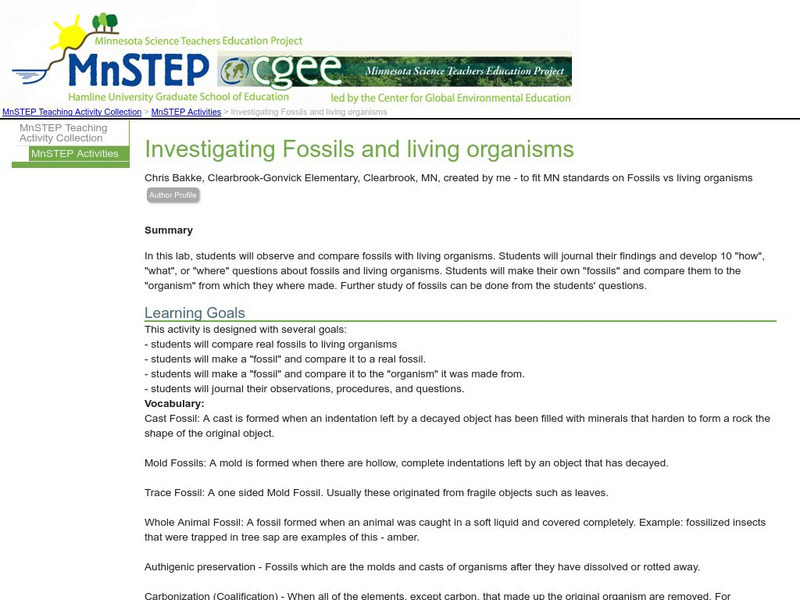Curated OER
Fossils
In this fossils worksheet, students review the different types of fossils including index and trace fossils. This worksheet has 6 matching and 9 true or false questions.
Curated OER
Make a Cast of a Tyrannosaurus rex Fossil
Second graders examine the formation of fossils and list the different types. They make cast model of a dinosaur fossil. They write about conditions that are necessary for fossils to form and create a model of a buried fossil.
Curated OER
Fossils
Young scholars discuss the work of a paleontologist and examine several fossils and books on paleontology. They use clay and Plaster of Paris to create a cast of an object and compare this activity to the formation of fossils in nature.
Curated OER
Fossilworks
Students research fossils and fossil formation. They explain how fossils are formed, identify fossil formations and use casting plaster to produce fossil replicas.
Curated OER
Earth's History
Seventh graders study the law of superposition by creating models of fossils in layers of rock. They examine how fossils are usually found in sedimentary rock which leads to the study of geologic history in those rocks.
Curated OER
Earth's History
Sixth graders investigate how fossils are formed. They analyze a photo of the Grand Canyon, and create a fossil cast and mold using plaster of paris and shells.
Curated OER
Investigation 4 - Dinosaurs Tracks
Fourth graders make inferences and interpretations from sets of dinosaur tracks. They describe Utah fossils and how they were formed. Partners trade their sketches of tracks and try to guess which dinosaur it belonged to.
American Museum of Natural History
A Whale of a Tale
What's the most interesting fact about a blue whale? Learners read an interview about the similarities between the Titanosaur and the blue whale displays at the American Museum of Natural History. Pupils learn not only about blue whales...
Other
Arizona Sonora Desert Museum: Make a Fossil Mold and Cast [Pdf]
For this activity, students will make a fake fossil cast using plaster of Paris. A second activity on comprehending the size of dinosaurs is included in this file.
Children's Museum
The Children's Museum of Indianapolis: Mold and Cast
Learners will define the term fossil, identify the difference between a mold and a cast fossil, and understand how scientists use models to learn about the physical structure of something in the natural world.
University of Florida
Florida Museum of Natural History: Make a Fossil
This activity demonstrates the process of fossilization by making mold and cast fossils.
Science Education Resource Center at Carleton College
Serc: Make a Model Fossil
This activity will show students two different ways fossils can be made. They will form and discuss the differences between a "mold" and a "cast" model fossil(s).
Science Education Resource Center at Carleton College
Serc: Investigating Fossils and Living Organisms
For this lab, students will observe and compare fossils with living organisms by making a "fossil" and comparing it to a real fossil and the "organism" it was made from.
Science Struck
Science Struck: Types of Fossils
Describes four different kinds of fossils and how they form.








![Arizona Sonora Desert Museum: Make a Fossil Mold and Cast [Pdf] Lesson Plan Arizona Sonora Desert Museum: Make a Fossil Mold and Cast [Pdf] Lesson Plan](http://content.lessonplanet.com/resources/thumbnails/410007/large/bwluav9tywdpy2symdiwmduymc0xotaxmy0xywl5yxlulmpwzw.jpg?1589984663)



